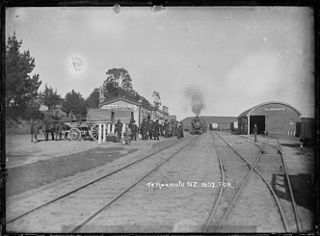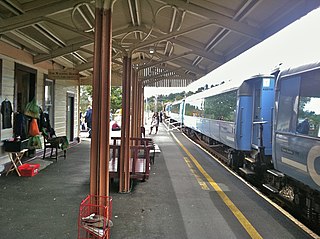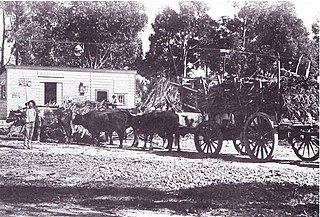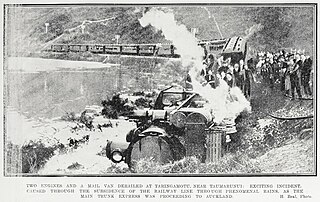| year | tickets | season tickets | staff | source | title |
| 1888 | 1,600 | | 1 | https://paperspast.natlib.govt.nz/parliamentary/appendix-to-the-journals-of-the-house-of-representatives/1889/I/1068?large_image=true | RETURN No. 10. STATEMENT of Revenue and Expenditure of each Station for the Twelve Months ending 31 March 1888 |
| 1908 | 11,955 | 12 | 5 | https://paperspast.natlib.govt.nz/parliamentary/appendix-to-the-journals-of-the-house-of-representatives/1908/I/2061 | RETURN No. 12. STATEMENT of Revenue and Expenditure of each Station for the Year ended 31 March 1908 |
| 1909 | 19,530 | 67 | 10 | https://paperspast.natlib.govt.nz/parliamentary/appendix-to-the-journals-of-the-house-of-representatives/1909/II/1832 | RETURN No. 12. STATEMENT of Revenue and Expenditure of each Station for the Year ended 31 March 1909 |
| 1910 | 22,033 | 39 | 9 | https://paperspast.natlib.govt.nz/parliamentary/appendix-to-the-journals-of-the-house-of-representatives/1910/I/2050 | RETURN No. 12. STATEMENT of Revenue and Expenditure of each Station for the Year ended 31 March 1910 |
| 1911 | 26,284 | 137 | 9 | https://paperspast.natlib.govt.nz/parliamentary/appendix-to-the-journals-of-the-house-of-representatives/1911/I/2497 | RETURN No. 12. STATEMENT of Revenue and Expenditure of each Station for the Year ended 31 March 1911 |
| 1912 | 35,314 | 76 | 11 | https://paperspast.natlib.govt.nz/parliamentary/appendix-to-the-journals-of-the-house-of-representatives/1912/II/2420 | RETURN No. 12. STATEMENT of Revenue and Expenditure of each Station for the Year ended 31 March 1912 |
| 1913 | 37,131 | 124 | 15 | https://paperspast.natlib.govt.nz/parliamentary/appendix-to-the-journals-of-the-house-of-representatives/1913/I/3693 | RETURN No. 12. STATEMENT of Revenue and Expenditure of each Station for the Year ended 31 March 1913 |
| 1914 | 37,856 | 157 | | https://paperspast.natlib.govt.nz/parliamentary/appendix-to-the-journals-of-the-house-of-representatives/1914/I/2031 | RETURN No. 12. Statement of Revenue for each Station for the Year ended 31 March 1914 |
| 1915 | 40,989 | 121 | | https://paperspast.natlib.govt.nz/parliamentary/appendix-to-the-journals-of-the-house-of-representatives/1915/I/1638 | RETURN No. 12. Statement of Revenue for each Station for the Year ended 31 March 1915 |
| 1916 | 46,256 | 143 | | https://paperspast.natlib.govt.nz/parliamentary/appendix-to-the-journals-of-the-house-of-representatives/1916/I/1053 | RETURN No. 12. Statement of Revenue for each Station for the Year ended 31 March 1916 |
| 1917 | 45,307 | 210 | | https://paperspast.natlib.govt.nz/parliamentary/appendix-to-the-journals-of-the-house-of-representatives/1917/I/1123 | RETURN No. 12. Statement of Revenue for each Station for the Year ended 31 March 1917 |
| 1918 | 44,454 | 207 | | https://paperspast.natlib.govt.nz/parliamentary/appendix-to-the-journals-of-the-house-of-representatives/1918/I-II/1159 | RETURN No. 12. Statement of Revenue for each Station for the Year ended 31 March 1918 |
| 1919 | 47,470 | 161 | | https://paperspast.natlib.govt.nz/parliamentary/appendix-to-the-journals-of-the-house-of-representatives/1919/I/1231 | RETURN No. 12. Statement of Revenue for each Station for the Year ended 31 March 1919 |
| 1920 | 54,829 | 362 | | https://paperspast.natlib.govt.nz/parliamentary/appendix-to-the-journals-of-the-house-of-representatives/1920/I/1349 | RETURN No. 12. Statement of Revenue for each Station for the Year ended 31 March 1920 |
| 1921 | 60,712 | 282 | | https://paperspast.natlib.govt.nz/parliamentary/appendix-to-the-journals-of-the-house-of-representatives/1921/I-II/1452 | RETURN No. 12. Statement of Revenue for each Station for the Year ended 31 March 1921 |
| 1922 | 56,353 | 563 | | https://paperspast.natlib.govt.nz/parliamentary/appendix-to-the-journals-of-the-house-of-representatives/1922/I/1409 | RETURN No. 12. Statement of Revenue for each Station for the Year ended 31 March 1922 |
| 1923 | 54,492 | 451 | | https://paperspast.natlib.govt.nz/parliamentary/appendix-to-the-journals-of-the-house-of-representatives/1923/I-II/1321 | RETURN No. 12. Statement of Revenue for each Station for the Year ended 31 March 1923 |
| 1924 | 56,536 | 366 | | https://paperspast.natlib.govt.nz/parliamentary/appendix-to-the-journals-of-the-house-of-representatives/1924/I/2458 | RETURN No. 12. Statement of Revenue for each Station for the Year ended 31 March 1924 |
| 1925 | 59,092 | 419 | | https://paperspast.natlib.govt.nz/parliamentary/appendix-to-the-journals-of-the-house-of-representatives/1925/I/1804 | RETURN No. 12. Statement of Traffic and Revenue for each Station for the Year ended 31 March 1925 |
| 1926 | 59,363 | 623 | | https://paperspast.natlib.govt.nz/parliamentary/appendix-to-the-journals-of-the-house-of-representatives/1926/I/1930 | STATEMENT No. 18 Statement of Traffic and Revenue for each Station for the Year ended 31 March 1926 |
| 1927 | 55,784 | 902 | | https://paperspast.natlib.govt.nz/parliamentary/appendix-to-the-journals-of-the-house-of-representatives/1927/I/2230 | STATEMENT No. 18 Statement of Traffic and Revenue for each Station for the Year ended 31 March 1927 |
| 1928 | 50,060 | 454 | | https://paperspast.natlib.govt.nz/parliamentary/appendix-to-the-journals-of-the-house-of-representatives/1928/I/2628 | STATEMENT No. 18 Statement of Traffic and Revenue for each Station for the Year ended 31 March 1928 |
| 1929 | 51,133 | 667 | | https://paperspast.natlib.govt.nz/parliamentary/appendix-to-the-journals-of-the-house-of-representatives/1929/I/2090 | STATEMENT No. 18 Statement of Traffic and Revenue for each Station for the Year ended 31 March 1929 |
| 1930 | 51,039 | 571 | | https://paperspast.natlib.govt.nz/parliamentary/appendix-to-the-journals-of-the-house-of-representatives/1930/I/2212 | STATEMENT No. 18 Statement of Traffic and Revenue for each Station for the Year ended 31 March 1930 |
| 1931 | 54,436 | 444 | | https://paperspast.natlib.govt.nz/parliamentary/appendix-to-the-journals-of-the-house-of-representatives/1931/I-II/1778 | STATEMENT No. 18 Statement of Traffic and Revenue for each Station for the Year ended 31 March 1931 |
| 1932 | 43,379 | 378 | | https://paperspast.natlib.govt.nz/parliamentary/appendix-to-the-journals-of-the-house-of-representatives/1932/I-II/1934 | STATEMENT No. 18 Statement of Traffic and Revenue for each Station for the Year ended 31 March 1932 |
| 1933 | 43,925 | 347 | | https://paperspast.natlib.govt.nz/parliamentary/appendix-to-the-journals-of-the-house-of-representatives/1933/I/1388 | STATEMENT No. 18 Statement of Traffic and Revenue for each Station for the Year ended 31 March 1933 |
| 1934 | 45,773 | 505 | | https://paperspast.natlib.govt.nz/parliamentary/appendix-to-the-journals-of-the-house-of-representatives/1934/I/2278 | STATEMENT No. 18 Statement of Traffic and Revenue for each Station for the Year ended 31 March 1934 |
| 1935 | 50,191 | 381 | | https://paperspast.natlib.govt.nz/parliamentary/appendix-to-the-journals-of-the-house-of-representatives/1935/I/1326 | STATEMENT No. 18 Statement of Traffic and Revenue for each Station for the Year ended 31 March 1935 |
| 1936 | 56,666 | 390 | | https://paperspast.natlib.govt.nz/parliamentary/appendix-to-the-journals-of-the-house-of-representatives/1936/I/1552 | STATEMENT No. 18 Statement of Traffic and Revenue for each Station for the Year ended 31 March 1936 |
| 1937 | 67,514 | 359 | | https://paperspast.natlib.govt.nz/parliamentary/appendix-to-the-journals-of-the-house-of-representatives/1937/I/1896 | STATEMENT No. 18 Statement of Traffic and Revenue for each Station for the Year ended 31 March 1937 |
| 1938 | 65,919 | 297 | | https://paperspast.natlib.govt.nz/parliamentary/appendix-to-the-journals-of-the-house-of-representatives/1938/I/1652 | STATEMENT No. 18 Statement of Traffic and Revenue for each Station for the Year ended 31 March 1938 |
| 1939 | 61,697 | 231 | | https://paperspast.natlib.govt.nz/parliamentary/appendix-to-the-journals-of-the-house-of-representatives/1939/I/1970 | STATEMENT No. 18 Statement of Traffic and Revenue for each Station for the Year ended 31 March 1939 |
| 1940 | 62,456 | 108 | | https://paperspast.natlib.govt.nz/parliamentary/appendix-to-the-journals-of-the-house-of-representatives/1940/I/1314 | STATEMENT No. 18 Statement of Traffic and Revenue for each Station for the Year ended 31 March 1940 |
| 1941 | 64,188 | 123 | | https://paperspast.natlib.govt.nz/parliamentary/appendix-to-the-journals-of-the-house-of-representatives/1941/I/1203 | STATEMENT No. 18 Statement of Traffic and Revenue for each Station for the Year ended 31 March 1941 |
| 1942 | 77,160 | 292 | | https://paperspast.natlib.govt.nz/parliamentary/appendix-to-the-journals-of-the-house-of-representatives/1942/I/651 | STATEMENT No. 18 Statement of Traffic and Revenue for each Station for the Year ended 31 March 1942 |
| 1943 | 90,203 | 279 | | https://paperspast.natlib.govt.nz/parliamentary/appendix-to-the-journals-of-the-house-of-representatives/1943/I/679 | STATEMENT No. 18 Statement of Traffic and Revenue for each Station for the Year ended 31 March 1943 |
| 1944 | 93,147 | 116 | | https://paperspast.natlib.govt.nz/parliamentary/appendix-to-the-journals-of-the-house-of-representatives/1944/I/895 | STATEMENT No. 18 Statement of Traffic and Revenue for each Station for the Year ended 31 March 1944 |
| 1945 | 81,064 | 39 | | https://paperspast.natlib.govt.nz/parliamentary/appendix-to-the-journals-of-the-house-of-representatives/1945/I/969 | STATEMENT No. 18 Statement of Traffic and Revenue for each Station for the Year ended 31 March 1945 |
| 1946 | 81,524 | 67 | | https://paperspast.natlib.govt.nz/parliamentary/appendix-to-the-journals-of-the-house-of-representatives/1946/I/1548 | STATEMENT No. 18 Statement of Traffic and Revenue for each Station for the Year ended 31 March 1946 |
| 1947 | 77,837 | 79 | | https://paperspast.natlib.govt.nz/parliamentary/appendix-to-the-journals-of-the-house-of-representatives/1947/I/2495 | STATEMENT No. 18 Statement of Traffic and Revenue for each Station for the Year ended 31 March 1947 |
| 1948 | 69,958 | 92 | | https://paperspast.natlib.govt.nz/parliamentary/appendix-to-the-journals-of-the-house-of-representatives/1948/I/2521 | STATEMENT No. 18 Statement of Traffic and Revenue for each Station for the Year ended 31 March 1948 |
| 1949 | 68,323 | 99 | | https://paperspast.natlib.govt.nz/parliamentary/appendix-to-the-journals-of-the-house-of-representatives/1949/I/2104 | STATEMENT No. 18 Statement of Traffic and Revenue for each Station for the Year ended 31 March 1949 |
| 1950 | 67,472 | 70 | | https://paperspast.natlib.govt.nz/parliamentary/appendix-to-the-journals-of-the-house-of-representatives/1950/I/2366 | STATEMENT No. 18 Statement of Traffic and Revenue for each Station for the Year ended 31 March 1950 |




















